Campus News
Emerald predators: Ohlone tiger beetles reclaim territory with the help of local scientists
U.S. Fish and Wildlife Service biologists released 43 Ohlone tiger beetles to a new home in Santa Cruz County earlier this year with the help of UC Santa Cruz students and reserve managers


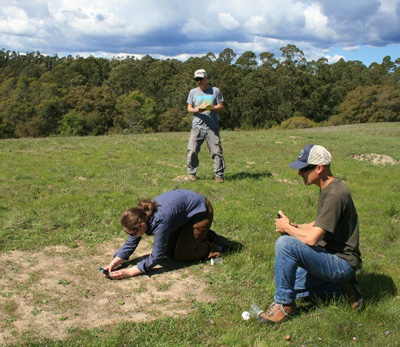
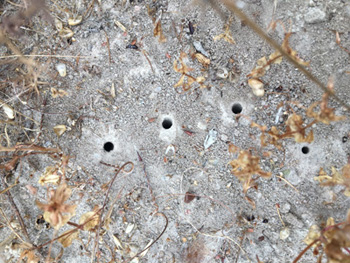
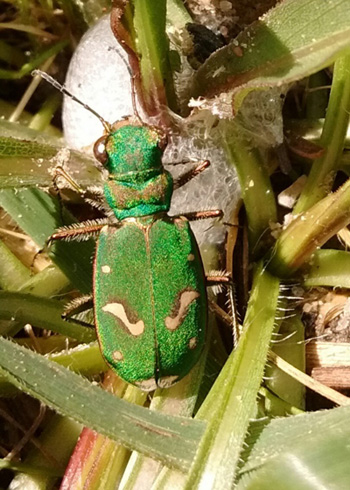
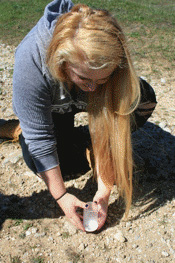
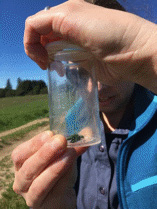
For the first time in over a decade, endangered Ohlone tiger beetles roam a preserve near Soquel and await their chance to pounce on unsuspecting prey. Their metallic emerald bodies appear iridescent in the sunlight as they scurry across the bare earth.
In the first-ever translocation of adult tiger beetles, U.S. Fish and Wildlife Service (USFWS) biologists released 43 Ohlone tiger beetles to a new home in Santa Cruz County earlier this year with the help of UC Santa Cruz students and reserve managers, local land managers, and tiger beetle experts from across the country. The translocated beetles came from stable populations in the UCSC Campus Natural Reserve and other nearby preserves.
The project’s goal is to establish a self-sustaining population of the rare beetles in an area of Santa Cruz County where they’ve been absent for more than a decade.
“The danger with any rare species is that any of the populations could be wiped out for any number of reasons in a given year,” explained USFWS biologist Chad Mitcham. “Its overall range would significantly decline with the loss of any one cluster.”
For a species whose remaining suitable habitat is estimated at 200 to 300 acres, the threat of extinction is real.
Entomologist Dick Arnold may have been the last person to see an Ohlone tiger beetle at the preserve near Soquel more than a decade ago.
“Unfortunately, the habitat conditions changed over time as more and more of the areas nearby got developed,” he said. As someone who’s studied rare insects for more than 40 years, Arnold said he’s delighted at the possibility of re-establishing a population where they’ve been extinct for more than 10 years.
A re-established population in this location, if it becomes self-sustaining, is critical for the tiger beetle’s long-term survival, explained Tara Cornelisse, a senior scientist with the Center for Biological Diversity who has studied the Ohlone tiger beetle for more than a decade, starting with her doctoral research at UC Santa Cruz. She helped train local resource managers to assist with the unprecedented translocation.
“It provides an insurance population for the species,” she said.
Lost populations
Ohlone tiger beetles likely inhabited a larger area before development around Santa Cruz reduced the extent and connectivity of their habitat. Populations lost from isolated sites may not be recolonized naturally, increasing the species’ overall risk of extinction. The translocation project aims to give the beetle some help.
According to USFWS biologist Mark Ogonowski, the idea got its start in a 2016 conversation with Grey Hayes, a rangeland ecologist active in Ohlone tiger beetle conservation (who also earned his Ph.D. at UCSC). “Grey thought translocating beetles to properly managed sites where they used to occur could be successful and put us in touch with the experts who have made this project possible,” Ogonowski said.
Sixteen males and 27 females were hand-collected one-by-one using nets and vials from three locations in the county where tiger beetle populations are known to be stable. The animals were placed in ice chests and transported to the preserve, where land managers from the Center for Natural Lands Management have been working since last fall to prepare the area for its new inhabitants. The litter layer of dead grass and leaves was removed by raking, weeding, and hand-pulling vegetation to create the bare-ground habitat Ohlone tiger beetles need to survive.
They require open, bare areas to stalk their prey, and they lay their eggs in tiny burrows in the ground. Aptly named for the Native American tribe with which they co-existed for millennia, Ohlone tiger beetles have ferocious predatory instincts. With excellent vision, they lie still on the bare ground and stealthily pounce on ants and flies that enter their line of sight.
“They’re like green jewels with jaws like the fangs of a saber tooth tiger,” Cornelisse says. “People are delighted when they see them.”
They’re also an important part of the food chain and are prey for a variety of animals, from birds and toads to lizards and dragonflies, Arnold said. “Anytime you start to lose species in a food chain, it weakens the whole system,” he said. “You don’t know how many can be lost before the whole food chain collapses.”
Endangered
In 2001, due to habitat loss, invasive grasses, and lack of natural disturbance, the Ohlone tiger beetle was designated as endangered by the U.S. Fish and Wildlife Service. While the designation secured protections for the beetle, proactive management and recovery efforts would be required to bring the species back from the brink.
The beetles transferred to the site near Soquel came from Glenwood and Moore Creek Preserves and natural reserve lands on the UC Santa Cruz campus. Today, rotational livestock grazing, prescribed burns, non-native vegetation removal, and even mountain biking trails all play key roles in the survival of the Ohlone tiger beetle.
Matt Timmer, natural resource manager with the Land Trust of Santa Cruz County, manages the 200-acre Glenwood Preserve in Scotts Valley. Glenwood Preserve was established more than two decades ago to protect habitat for Ohlone tiger beetles and other rare plants and animals as mitigation from impacts of a housing development.
At Glenwood Preserve, Ohlone tiger beetles thrive in pastures grazed by cattle. The cattle form paths that create bare ground where the tiger beetles spend most of their time as adults.
“Historically, these grasslands would have consisted of perennial bunch grasses and forbs with patches of bare ground. With the arrival of European settlers, livestock, and non-native grasses, that system has changed over time,” says Timmer. “Today, we’re using grazing to try to mimic historical conditions, like the large herds of ungulates that once roamed the area, to create more suitable habitat for the beetle.”
UC Santa Cruz created two preserves on campus through a habitat conservation plan put in place to mitigate impacts to Ohlone tiger beetles and other federally protected wildlife from a faculty and staff housing development. Some of the now-preserved lands are used for academic research, grazing, and recreation, and provide much-needed habitat for Ohlone tiger beetles to carry out their life cycle.
“Santa Cruz County has a lot of open space that people use and appreciate. People are already in love with this area,” said Alex Jones, who manages the UCSC Campus Natural Reserve. “We should celebrate the tiger beetle and Endangered Species Act as one of the reasons we have so much open space here in Santa Cruz. Conservation of tiger beetles has allowed for some of this open space to exist.”
Jones recruits UCSC students to conduct Ohlone tiger beetle surveys, a source of key data to further the conservation of this species.
Wilder Ranch State Park boasts one of the more stable Ohlone tiger beetle populations in the county, a testament to successful ongoing management activities, from prescribed burns to the creation and management of mountain biking trails. If this initial translocation proves successful, additional beetles may be translocated from Wilder State Park to the preserve near Soquel to further augment the new population.
Habitat loss
More than 100 species of tiger beetles are known in the U.S. and Canada alone, and five of them are listed as threatened or endangered. Barry Knisley, who has been studying tiger beetles for more than 40 years, said, “Like so many organisms, there is clearly a decline. We’re losing habitat as development and urbanization and human activity progress. As we lose natural areas, we’re losing tiger beetles.”
Knisley, who played a role in securing protections for several species of tiger beetle across the United States, perfected larval translocation to boost dwindling populations and consults on the Ohlone tiger beetle adult translocation project in Santa Cruz.
“There’s good evidence that larval translocation works, and now we’d like to see if adult translocation can also be successful,” he said. “We do know, unlike vertebrate animals, that tiger beetles can rebound genetically and biologically if the habitat is suitable. If we double the number of sites, we have a chance.”
The team continues to monitor the new arrivals at their new home, and early observations appear promising. In the hours and days following release, the beetles were observed hunting and mating.
“No one knew what to expect, but we knew what we wanted to see happen. Hunting and mating are exactly that,” Mitcham said. “It’s a very good sign.”
Mitcham and the rest of the team remain hopeful that this first-ever translocation will be the first of more to come, steps that will bring this enigmatic species one step closer to recovery. “They’re ambassadors for insect conservation and the health of the prairies, and they’re worth saving,” he said.